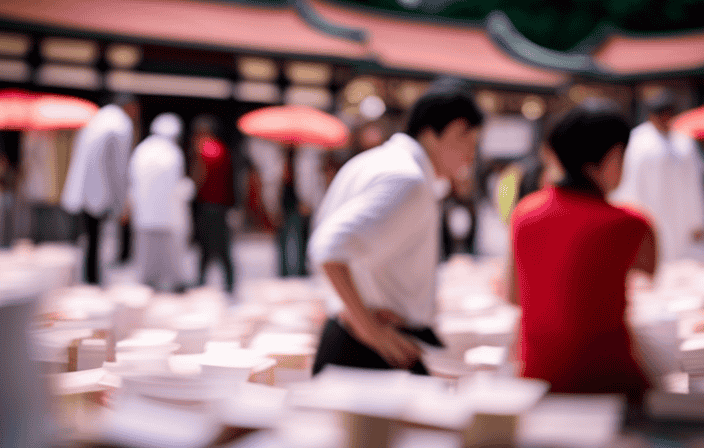Aligned with the rise and fall of Japanese cultural practices, Omikuji stands out as a fascinating and mysterious method of predicting the future. Embedded in the relationship between people and the spiritual realm, Omikuji provides a peek into what the future might hold via fortunes drawn at random.
This article aims to delve into the customs, beliefs, and significance of Omikuji in Japanese culture. By unraveling the mysteries surrounding this age-old practice, we seek to provide a deeper understanding of how Omikuji impacts the lives of those who engage with this intriguing form of fortune-telling.
Key Takeaways
- Omikuji is a popular method of fortune-telling in Japan that is random and unpredictable.
- Omikujis can bring both good and bad fortune, with specific fortunes described in the rest of the Omikuji.
- Customs and beliefs surrounding Omikuji include leaving bad fortunes behind to transfer bad luck and keeping good fortunes close.
- Omikuji is deeply rooted in Japanese culture and traditions, reflecting the belief in the connection between humans and the divine.
What is it?
Omikuji, a popular method of fortune-telling in Japan, is an enigmatic tradition deeply rooted in Japanese culture and associated with shrines and temples. It encompasses various rituals and holds significant cultural importance.
Omikuji rituals involve individuals drawing a numbered stick from a container and exchanging it for a corresponding fortune slip. These fortunes, written on small pieces of paper, provide insights into various aspects of life, ranging from blessings to curses.
The practice of omikuji is considered a form of spiritual practice, where individuals seek guidance and insights into their future. It reflects the belief in the connection between humans and the divine.
The cultural significance of omikuji is evident through its association with shrines and temples, where individuals partake in the tradition as a means of seeking spiritual guidance and understanding their destiny.
Customs and Beliefs
Customs and beliefs surrounding the practice of fortune-telling in Japan involve various rituals and practices associated with the interpretation and handling of the fortunes received.
When it comes to omikuji, the handling of fortunes is of utmost importance. It is believed that leaving bad fortunes behind can transfer the bad luck, therefore, many individuals avoid taking these fortunes home with them. On the other hand, keeping good fortunes close is a common practice as it is believed to attract positive energy and blessings. Some individuals even carry their good fortunes with them for an extended period of time.
Leaving good fortunes behind is seen as selfless and can potentially cancel out the bad fortunes for others. These customs reflect the belief in the power of omikuji and the importance of managing one’s fortune in order to navigate through life.
Understanding Fortunes
One fascinating aspect of omikuji fortunes is the wide range of blessings and curses they can encompass, extending to various areas of life.
Interestingly, a survey conducted in Japan revealed that 70% of respondents believe in the power of omikuji to accurately predict their future outcomes.
To gain a deeper understanding of these fortunes, it is important to explore how they are interpreted.
Interpreting omikuji fortunes can vary depending on the individual and their beliefs. Different interpretations of daikichi (a great blessing) and daikyo (a great curse) can also be found.
Some may interpret daikichi as a positive outcome in all aspects of life, while others may focus on specific areas such as love, career, or health.
Similarly, daikyo can be seen as a general misfortune or as a warning in a particular area of life.
These different interpretations reflect the subjective nature of omikuji fortunes and the individual’s personal beliefs and experiences.
Finding and Interacting
Shrines and temples in Japan are the primary locations where individuals can find and engage with omikuji. These spiritual sites have long been associated with the tradition of omikuji, and visitors often seek guidance and insights into their future through this practice.
In the past, obtaining an omikuji involved drawing a numbered stick, which was then exchanged for a written fortune by a priest or Miko. However, with the increasing popularity of omikuji, convenient methods have been introduced. Nowadays, omikuji can be found in small boxes for a fee, allowing individuals to easily obtain their fortunes.
While traditional rituals and interactions with omikuji still exist, these modern methods have made the practice more accessible to a wider audience.
Significance in Culture
Deeply ingrained in the cultural fabric of Japan, omikuji serves as a conduit between individuals and the divine, embodying the profound belief in the interconnection of human existence and spiritual guidance. This traditional fortune-telling practice holds significant importance in Japanese society, impacting daily life and playing a central role in festivals and celebrations.
-
Impact on daily life: Omikuji’s influence extends beyond mere curiosity or entertainment. Many individuals view the fortunes as guidance for decision-making, seeking insights into various aspects of their lives, such as relationships, career paths, or health. The omikuji’s predictions can shape their actions and choices, reflecting the belief in the power of divine intervention.
-
Role in festivals and celebrations: Omikuji is an integral part of religious and cultural events in Japan. During New Year’s celebrations, for example, people flock to shrines and temples to draw omikuji, hoping for a positive start to the year. Additionally, omikuji are commonly offered during other significant occasions like weddings, birthdays, and the birth of a child, symbolizing the desire for blessings and good fortune in these special moments.
Availability at Shrines
Widely accessible at various religious sites, omikuji can be conveniently obtained by individuals seeking spiritual guidance and insights into their future. The availability of omikuji at shrines and temples in Japan reflects the popularity and cultural significance of this fortune-telling tradition.
In the past, acquiring an omikuji required drawing a numbered stick and exchanging it for the corresponding fortune. However, due to the increasing demand and convenience, omikuji are now often found in small boxes that can be purchased for a fee. This accessible method allows visitors to easily participate in this age-old practice.
By obtaining an omikuji, individuals can engage in a form of spiritual practice and seek guidance from the divine forces believed to influence human destiny.
Translation for Tourists
For tourists visiting Japan, it may be necessary to seek translation services when encountering omikuji, as these fortunes are typically written in Japanese.
Omikuji, the popular method of fortune-telling in Japan, holds significant cultural significance and is deeply rooted in Japanese traditions.
However, English omikujis are extremely rare, making it challenging for non-Japanese speakers to understand the fortunes.
Translation services can help bridge this gap and allow tourists to fully engage with the omikuji tradition.
By providing translations, tourists can gain insights into their fortunes and understand the blessings or curses that await them.
This service enables a deeper appreciation and understanding of Japanese culture and the spiritual practice associated with omikuji.
Furthermore, translation services can enhance the overall tourist experience by providing a more inclusive and accessible environment for visitors from all backgrounds.
Rare English Omikujis
Scarcely found, English translations of omikujis are as elusive as a rare gem hidden among a sea of foreign symbols. For tourists visiting Japan who are unfamiliar with the Japanese language, the lack of English omikujis can pose a challenge when trying to understand and interpret their fortunes. This linguistic barrier may prevent non-Japanese speakers from fully participating in this traditional fortune-telling practice.
The rarity of English omikujis reflects the cultural significance and exclusivity of this tradition within Japanese society. Omikujis are deeply rooted in Japanese culture and are primarily intended for the local population, making them less accessible to foreigners. By withholding English translations, omikujis maintain their authenticity and preserve their traditional value.
This exclusivity adds an air of mystique and intrigue to the practice, further enhancing its allure for those who seek a glimpse into the enigmatic world of Japanese fortune-telling.
Frequently Asked Questions
How long has the tradition of Omikuji been practiced in Japan?
The tradition of Omikuji has been practiced in Japan for a significant period of time, although the exact origins are unclear. It holds great significance in Japanese culture as a way to seek guidance and insights into the future.
Are there any specific rituals or prayers associated with drawing an Omikuji?
Prayer rituals and Omikuji customs are integral to the experience of drawing an Omikuji. These practices reflect the spiritual connection between individuals and the divine, allowing seekers to seek guidance and insights into their future.
What are some common superstitions or taboos related to Omikuji?
Common omikuji taboos include not reading the fortune on the shrine or temple grounds, not taking home a bad fortune, and not tying a bad fortune to a tree. Omikuji holds importance in Japanese culture as a form of seeking guidance and reflecting the belief in the connection between humans and the divine.
Are there any famous shrines or temples in Japan that are particularly renowned for their Omikuji?
Famous omikuji destinations in Japan include Meiji Shrine, Senso-ji Temple, and Kiyomizu-dera Temple. These popular shrines and temples are renowned for their omikuji, which offer a variety of charms and predictions for visitors seeking guidance and insights into their future.
Are there any variations or regional differences in the way Omikuji is practiced throughout Japan?
Variations in omikuji practices and regional differences in customs exist throughout Japan. Different shrines and temples may have their own unique rituals and methods of distributing omikuji, reflecting the diverse cultural and religious traditions of each region.










